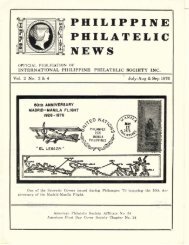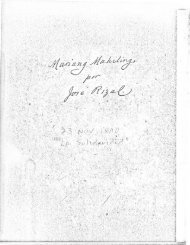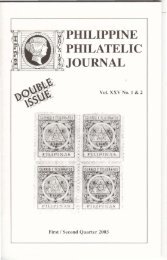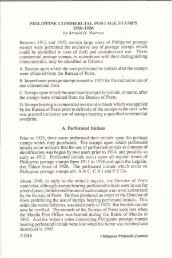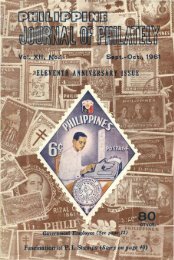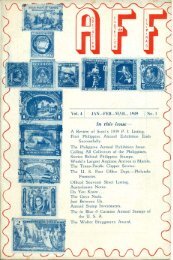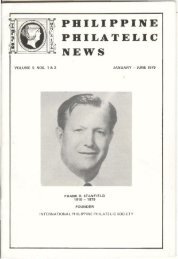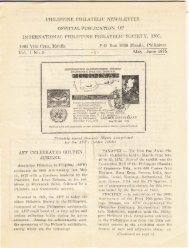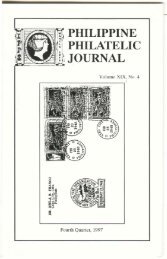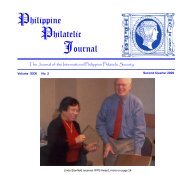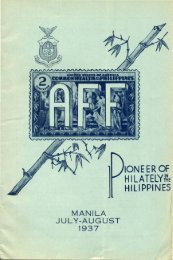April-December 1977, Vol. 3, No.s 2-4 - International Philippine ...
April-December 1977, Vol. 3, No.s 2-4 - International Philippine ...
April-December 1977, Vol. 3, No.s 2-4 - International Philippine ...
Create successful ePaper yourself
Turn your PDF publications into a flip-book with our unique Google optimized e-Paper software.
A MOST UNUSUAL REFUGEE CAMP<br />
By LArry Klemme<br />
1420 Solana Dr.<br />
Belmont, Calif. 94002<br />
For a student of postal history, the mere knowledge of a story is not sufficient, he must have philatelic<br />
ploof.<br />
For years, I was told that phiatelic proof of this camp could not exist. Why Because this camp could<br />
never have existed. The supposed peoples in this camp would never have been able to assimilate into a Cathotic,<br />
Phi1ippine, society (partly true).<br />
This article with accompanying photos will forever dispute this line of thinking.<br />
I would like to share with fellow collectors what little information I have regarding this camp. Maybe<br />
the following will help to further expand this one small aspect of United Nations related postal history.<br />
A few years ago. quite by accident, I came across this simple cover. It was my lust. hence it is of special<br />
importance to me. It opened up a whole area of philately that has been overlooked, and it prompted me<br />
to begin a research project on these covers that continues to this day.<br />
The fust thing that caught my eyes was the odd hand cancel and the unusual address. Second,<br />
I thought it strange that a registered cover with a Brooklyn, New York return address should be posted from<br />
the small town of St. Nicolass on the tiny island of Aruba. The face of the cover was cancelled in St. Nicolass<br />
on October 15, 1949. On the reverse side of the cover, the back-stamping begins to unfold a rather interesting<br />
journey. Two days later, on October 17, it was received at Oranjestad, the main city of Aruba. On<br />
October 19, it reached Miami, Florida. On October 20, it was in San Francisco, California. On October 24, it<br />
was in Manila, and, on October 28, it reached a post office at Guiuan, on the island of Samar, in the <strong>Philippine</strong>s.<br />
So, is this the end <strong>No</strong>, this is just the BEGINNING. Something is extremely odd. Guiuan, in 1949,<br />
was nothing more than a native jungle village. A letter from there, in my possession, authenticates this. And<br />
to think they had a post office Stranger yet, once this cover was received there, not only did it get a Guiuan<br />
back-stamp, but someone applied a circular hand-cancel to the face which reads IRG-UNEC. Why<br />
I was positive that it had something to do with the United Nations. 1 In a reply from an expert on the<br />
United Nations, [ found that I was right. The letters "IRO" represent the United Nations <strong>International</strong><br />
Refugee Organization and the letters uUNEC' represent the United Nations Evacuation Center. But from<br />
whom This simple Guiuan cancel begins to unfold a most interesting story.<br />
When the Ukranians (White Russians) fled from the Russian evolution, a great many landed in <strong>No</strong>rthern<br />
China. Then again in the late forties, they had to flee the Chinese Communists. Only this time they<br />
were homeless and were referred to as uThe Shanghai Refugees", Hence, they came under the jurisdiction<br />
of the IRO, whose function in the post World War II era was to relocate the masses of displaced persons.<br />
"And of all the groups of peoples that the IRO was called upon to handle, this group of refugees were by far<br />
the hardest to relocate. They consisted mainly of Whitle Collar workers, government officials, police officials,<br />
and others, about ten percent were intellectuals. Psychologically, they had remained refugees. Conditions<br />
in China had effectively prevented their assimilation into a normal life. The older ones among them<br />
still retained the hope of a victorious return into Russia, and the idea was common that, as they were the<br />
earliest refugees from the Bolsheviks, the world owed them something".2<br />
Due to politics, no country would accept them as a group. Finally, in <strong>April</strong>, 1949, the <strong>Philippine</strong><br />
government agreed to Utent" them, UBut for only eighteen months", on the tiny, God-forsaken jungle island<br />
of Tubabao. Tubabao was connected by a bridge to the southern tip of the main island, Samar, which<br />
is located on the western side of the <strong>Philippine</strong>s at approximately the twelfth latitude, about ruteen miles<br />
from Guiuan.<br />
In the heart of the typhoon belt. in a tent Needless to say, the living conditions in this camp were<br />
absolutely miserable. The refugees were told by the IRO that they would be there for foUl months. They<br />
were there nearly foUl years!<br />
Another stipulation by the <strong>Philippine</strong> government was that not one refugee could remain in the<br />
<strong>Philippine</strong>s, nor were they allowed to work outside the camp.<br />
47




